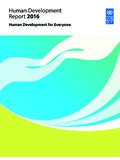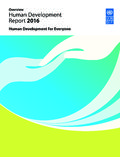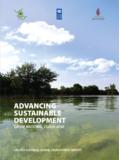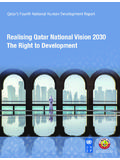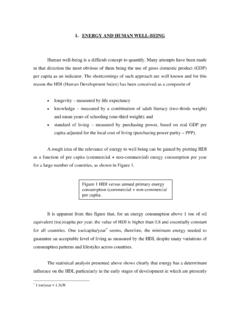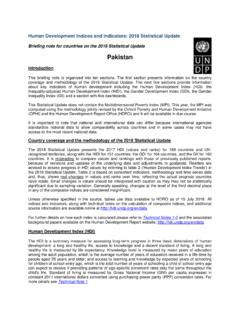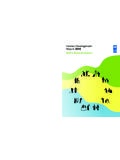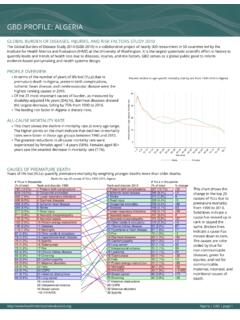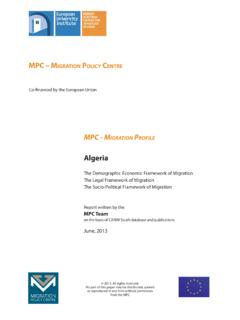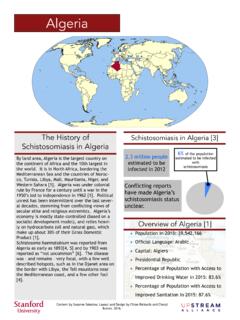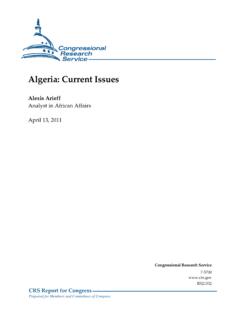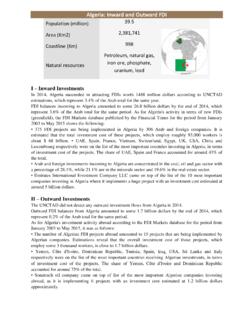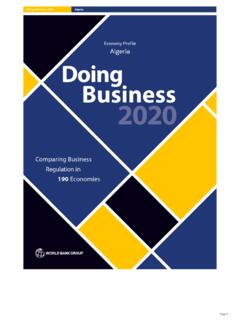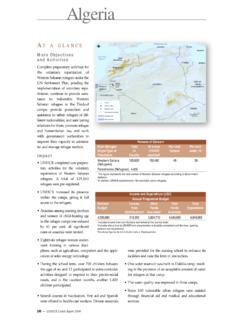Transcription of Algeria - Human Development
1 1 Human Development Report 2019 Inequalities in Human Development in the 21st Century Briefing note for countries on the 2019 Human Development Report Algeria Introduction The main premise of the Human Development approach is that expanding peoples freedoms is both the main aim of, and the principal means for sustainable Development . If inequalities in Human Development persist and grow, the aspirations of the 2030 Agenda for Sustainable Development will remain unfulfilled. But there are no pre-ordained paths. Gaps are narrowing in key dimensions of Human Development , while others are only now emerging. Policy choices determine inequality outcomes as they do the evolution and impact of climate change or the direction of technology, both of which will shape inequalities over the next few decades.
2 The future of inequalities in Human Development in the 21st century is, thus, in our hands. But we cannot be complacent. The climate crisis shows that the price of inaction compounds over time as it feeds further inequality, which, in turn, makes action more difficult. We are approaching a precipice beyond which it will be difficult to recover. While we do have a choice, we must exercise it now. Inequalities in Human Development hurt societies and weaken social cohesion and people s trust in government, institutions and each other. They hurt economies, wastefully preventing people from reaching their full potential at work and in life.
3 They make it harder for political decisions to reflect the aspirations of the whole society and to protect our planet, as the few pulling ahead flex their power to shape decisions primarily in their interests. Inequalities in Human Development are a defining bottleneck in achieving the 2030 Agenda for Sustainable Development . Inequalities in Human Development are not just about disparities in income and wealth. The 2019 Human Development Report (HDR) explores inequalities in Human Development by going beyond income, beyond averages, and beyond today. The proposed approach sets policies to redress these inequalities within a framework that links the formation of capabilities with the broader context in which markets and governments function.
4 Policies matter for inequalities. And inequalities matter for policies. The Human Development lens is central to approaching inequality and asking why it matters, how it manifests itself and how best to tackle it. Imbalances in economic power are eventually translated into political dominance. And that, in turn, can lead to greater inequality and environmental disasters. Action at the start of this chain is far easier than relying on interventions farther down the track. The 2019 HDR contributes to that debate by presenting the facts on inequalities in Human Development and proposing ideas to act on them over the course of the 21st century.
5 This briefing note is organized into seven sections. The first section presents information on the country coverage and methodology for the 2019 Human Development Report. The next five sections provide information about key composite indices of Human Development : the Human Development Index (HDI), the Inequality-adjusted Human Development Index (IHDI), the Gender Development Index (GDI), the Gender Inequality Index (GII), and the Multidimensional Poverty Index (MPI). The final section covers five dashboards: quality of Human Development , life-course gender gap, women s empowerment, environmental sustainability, and socioeconomic sustainability.
6 2 It is important to note that national and international data can differ because international agencies standardize national data to allow comparability across countries and in some cases may not have access to the most recent national data. 1- Country coverage and the methodology of the 2019 Human Development Report The 2019 Human Development Report presents the 2018 HDI (values and ranks) for 189 countries and UN-recognized territories, along with the IHDI for 150 countries, the GDI for 166 countries, the GII for 162 countries, and the MPI for 101 countries. It is misleading to compare values and rankings with those of previously published reports, because of revisions and updates of the underlying data and adjustments to goalposts.
7 Readers are advised to assess progress in HDI values by referring to Table 2 ( Human Development Index Trends ) in the 2019 Human Development Report. Table 2 is based on consistent indicators, methodology and time-series data and, thus, shows real changes in values and ranks over time, reflecting the actual progress countries have made. Small changes in values should be interpreted with caution as they may not be statistically significant due to sampling variation. Generally speaking, changes at the level of the third decimal place in any of the composite indices are considered insignificant. Unless otherwise specified in the source, tables use data available to the Human Development Report Office (HDRO) as of 15 July 2019.
8 All indices and indicators, along with technical notes on the calculation of composite indices, and additional source information are available online at For further details on how each index is calculated please refer to Technical Notes 1-6 and the associated background papers available on the Human Development Report website: 2- Human Development Index (HDI) The HDI is a summary measure for assessing long-term progress in three basic dimensions of Human Development : a long and healthy life, access to knowledge and a decent standard of living. A long and healthy life is measured by life expectancy.
9 Knowledge level is measured by mean years of schooling among the adult population, which is the average number of years of schooling received in a life-time by people aged 25 years and older; and access to learning and knowledge by expected years of schooling for children of school-entry age, which is the total number of years of schooling a child of school-entry age can expect to receive if prevailing patterns of age-specific enrolment rates stay the same throughout the child's life. Standard of living is measured by Gross National Income (GNI) per capita expressed in constant 2011 international dollars converted using purchasing power parity (PPP) conversion rates.
10 For more details see Technical Note 1. To ensure as much cross-country comparability as possible, the HDI is based primarily on international data from the United Nations Population Division (the life expectancy data), the United Nations Educational, Scientific and Cultural Organization Institute for Statistics (the mean years of schooling and expected years of schooling data) and the World Bank (the GNI per capita data). As stated in the introduction, the HDI values and ranks in this year s report are not comparable to those in past reports because of some revisions to the component indicators.
